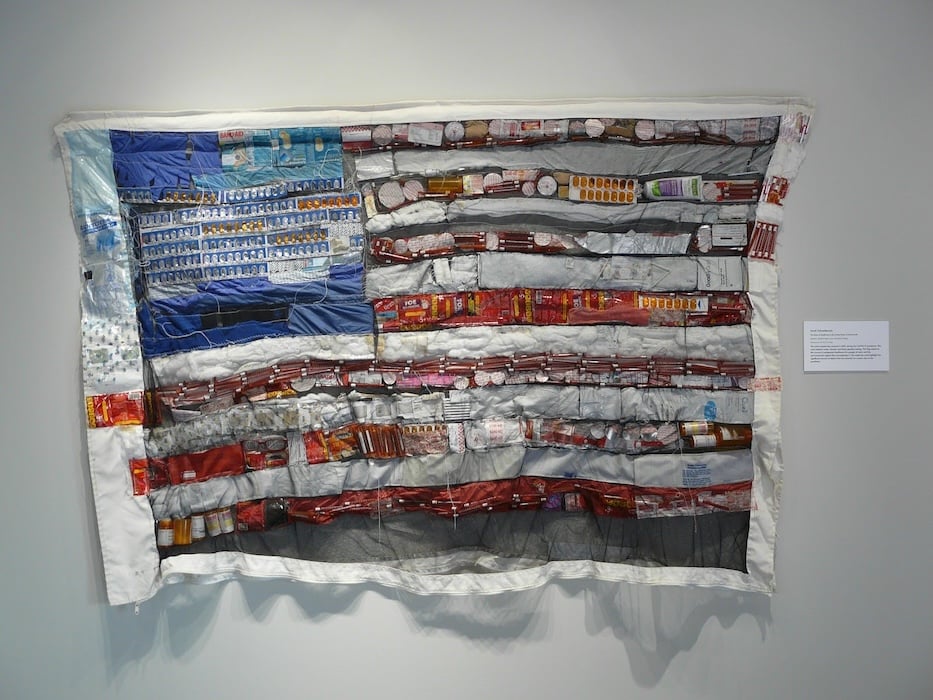
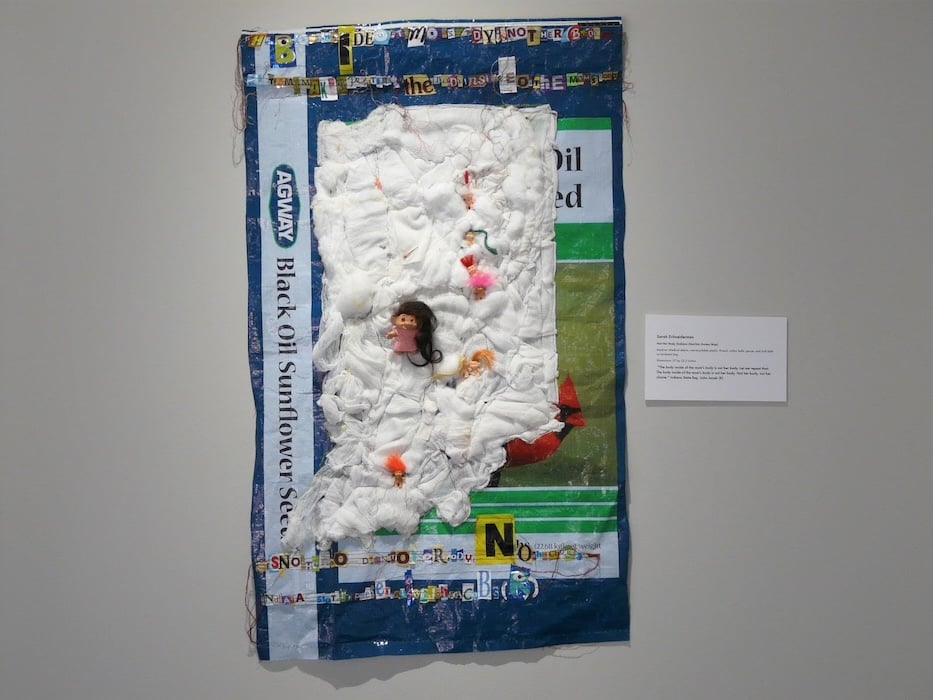
Top: Sarah Schneiderman’s The State of Healthcare in the United States of America #4. Bottom: Not Her Body. Mason Angkapatyakit Photos.
There’s a birdseed bag with gauze and cotton balls stitched onto it, forming the shape of Indiana. On top of that, little Trolls dolls are attached in the gauze. There's one big one near the middle of the state, another closer to where Indianapolis and Franklin would be. It pokes out, fully visible. To the east of the big doll, smaller ones are buried in the gauze, swaddled in white cotton balls.
On the very top of the birdseed bag, ransom-note-like text reads: “The body inside the mom's body is not her body. Let me repeat that, the body inside the mom's body.” The words resume at the very bottom: “Is not her body. Not her body, not her choice.”
The words, spoken by Indiana State Rep. John Jacobs, are part of Not Her Body, one of the 13 pieces in Sarah Schneiderman’s most recent exhibition, Red, White, and Bruised. The exhibition closed at Ball & Socket Arts in Cheshire last month. The show, which addressed the healthcare system and recent reproductive laws made in the United States, is a wider part of Schneiderman’s oeuvre, which looks at failures of and inequities baked into the American healthcare system.
Schneiderman’s own family's experience with reproductive healthcare, particularly experiences with abortion among women in her family, helped shape the overall theme of her recent work. A few years ago, she started working on some of her earliest pieces during the Supreme Court’s decision to overturn Roe v. Wade.
“And when it was overturned, it was such a big setback for women's health,” she said. “ My work has socio-political implications anyway … And I was like, what can I do? Well, I'm an artist, this is what I can do.”
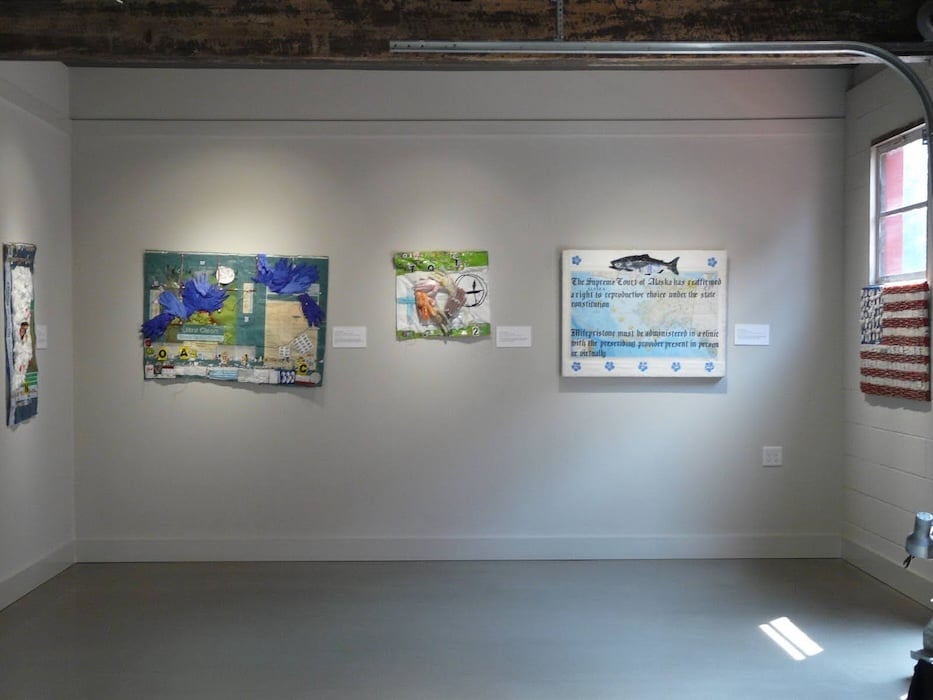
Installation view. Mason Angkapatyakit Photos.
Her first pieces started off as maps of the different states that already had “trigger” or “TRAP” (target restriction of abortion providers) laws on the books. In the world of reproductive justice, “trigger bans” or laws refer to legislation that is already in place to severely restrict or ban abortion without the protections of Roe v. Wade. Currently, 13 states enforce full bans on abortion, and 28 states have bans based on gestational age, according to the Guttmacher Institute.
Out of the 13 pieces in the exhibition, nine of them came out of Schneiderman’s work on state maps. Seven of the nine featured trigger law states; four were recreations of the flag of the United States.
As a viewer sees in pieces like The State of Healthcare in the United States of America #4, Schneiderman used medical waste and recycled materials for all of her works. Sourcing recycled materials and repurposing them for artwork is one of the staples of her art, and most of the medical waste used comes from her and her wife.
“This is just stuff that I've collected,” she said.
Some other notable pieces from the exhibition are “No” Vote, With God All Things Are Possible, and Bearing the Burden of Choice.
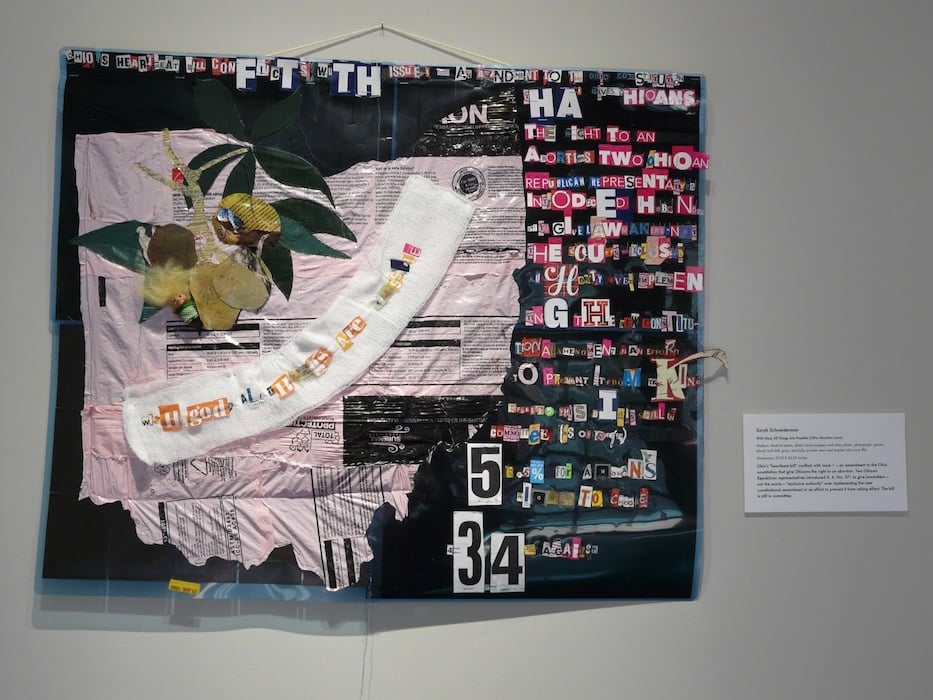
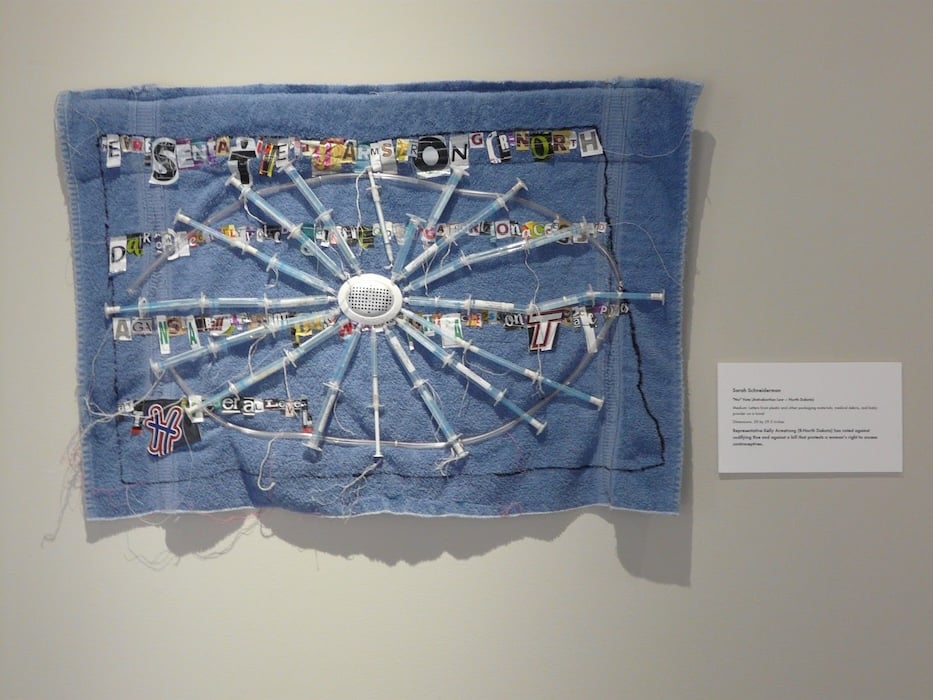
Top: With God, All Things Are Possible. Bottom: "No” Vote. Mason Angkapatyakit Photos.
“No” Vote, for instance, presents a visual take on former U.S. Rep. Kelly Armstrong’s vote against codifying Roe v. Wade (Armstrong is now the governor of North Dakota, where abortion is currently legal through fetal viability at 24 weeks of pregnancy, but there are no providers in the state). The work itself is a blue towel, with a Z-VAC rupture disk sewn into the middle with almost two dozen syringes pointed straight at it.
As they fall on the piece, a viewer's eyes immediately drift to the middle. The syringes draw attention, putting all of the spotlight on the speaker. Together, the components of the work give such a sense of urgency, which is what the piece is conveying. It asks its viewer to listen, to understand the state of reproductive healthcare services, and the erosion of women’s (and birthing people’s) rights at the hands of people with no chance of getting pregnant or needing an abortion.
Each piece has very intricate details, so much so that Schneiderman herself said it would take hours and hours to single out every one of them. One very big “detail” across the state pieces, however, is the intensive research she puts into the state she's depicting. For instance, she found herself fascinated by Ohio’s state motto, “With God All Things Are Possible.”
“What does that mean in access to healthcare, access to abortion, access to contraceptive activity?” she asked aloud during an interview on the work. She noted how many people position themselves as anti-choice due to their religious belief. There's no shame in that, she said—but why should one's belief limit another person's choice?
Once a viewer notices one detail, they quickly see how attentive and clever Scheinderman is with her art.

That’s especially true in her California-centered piece, one of two state maps that show a state being supportive of abortion rights and other reproductive healthcare. The Californian grizzly bear sits in the middle of the canvas, right on top of the state, as text shows previous actions in the state that support reproductive rights.
Schneiderman works wordplay into the title too: women have to bear children, just as they bear the choice to get an abortion. The piece clarifies that birthing people aren’t completely independent in this position: physicians make the call on fetal viability (normally 24 weeks, as is the cutoff in Connecticut).
The result, beyond just the show, is an artist who can draw viewers into the despair, the anger, and inadequacy surrounding women’s healthcare, and reproductive healthcare more broadly. Something is rotting at the core of this care—or rather, the increasingly restrictive laws that surround it—and Schneiderman is precise and clear-eyed as she addresses it head on.
“Sometimes I wonder why … Why aren’t I doing … Why don’t I be more directly active politically?” she said. “And then I recognize that I am by being an artist and making art about this subject matter.”
This article comes from the 2025 cohort of the Youth Arts Journalism Initiative (YAJI). YAJI is a program in which New Haven, Hamden and West Haven Public Schools high school students pitch, write, edit and publish articles through the Arts Paper. This year, YAJI advisors include Arts Paper Editor Lucy Gellman and reporter and YAJI alum Abiba Biao. Mason Angkapatyakit is a rising senior at Metropolitan Business Academy.